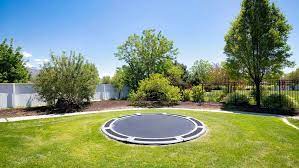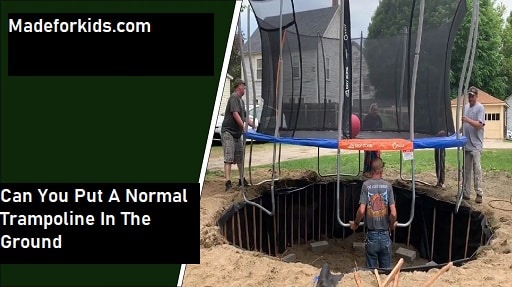When I was twenty-two years old, I wanted two things: 1. To be understood. 2. For people to think I was good at my job....Read more
You can put a normal trampoline on the ground, but it requires little effort and time. You will have to dig a hole in the ground for the trampoline. The depth of a hole will be different for small and big kids. It has to be done with proper guidelines and supervision.

Do not do all this lengthy process by yourself. Talk to a mechanical digger, and he will let you know what can be done with it. By reading this article, you will learn about many answers to questions that bug your mind. So, take a deep breath and read.
Also Read: Difference between inground and above ground trampoline
Can I put a regular trampoline in the ground?
Yes, you can put a regular trampoline in the ground because it just needs a few steps to carry out the process, although expert assistance is always needed! If you do it yourself, you can make a lot of mistakes, or you can be exhausted easily. On the other hand, a mechanical digger knows how to deal with the issues that come with the process.
Mental and physical benefits:
Trampoline gives great benefits to children mentally and physically. By jumping happily, they exert all the stored energy inside their bodies. Jumping makes them more active and powerful physically. All of the muscles involved while jumping on the trampoline gives amazing bodily benefits.
Safer option:
If we talk about safety In, ground trampolines are always safer than normal trampolines. It is because they are not raised above the ground. Parents can easily send their kids without any worry of seeing them falling off the ladder. Although supervision is still needed.
Must Read: Can You Wear Shoes On The Trampoline
How to put a normal trampoline on the ground?
Putting on a trampoline is easy, but you must do it with intense care and guidelines. Creating a level surface and digging a hole are the two main steps in the process.
The whole process is discussed below step by step:
1. Find a place in your yard. That place should have enough space to adjust the trampoline
Note: Make sure there are no hurdles like trees or power lines, so your kid can jump safely.
2. With a stone or a stick, mark the area where you plan to put your trampoline. That should be the best open and wide space in your yard.
Note: Remove and throw away all the rock or debris kind of stuff while preparing the area.
3. Now, you need to measure your trampoline frame in diameter. Remember, you have to dig a hole bigger than your trampoline frame.
Note :
The depth of the Hole depends on the type of trampoline frame. An estimated 2 to 3 feet ( 60-90 cm) deep is always recommended.
4: Now, you need to provide additional softness and cushioning to jumpers. For that, use sand wood chips or rubber to add a soft layer at the bottom of the Hole. All these materials are impact-absorbing and will provide safety.
Note: The level of the bottom of the Hole should be flat. You can also use a level tool to check that. Make sure there are no uneven spots. Adjust the ground as much as you can until it’s perfect.
5: Final step would be to place the trampoline. Don’t do it alone. Always include friends and family to do it with you. Kindly do not leave the trampoline until it’s all even on the safe layer.
Note: Fill all the gaps surrounding the trampoline with soil. It will provide more stability.
6: Regular checkups and maintenance will provide more safety and perfection to the trampoline. Please keep it clean from all kinds of dirt or debris.
Why put a trampoline in-ground?
Putting a trampoline is encouraged and recommended because it increases safety, and maintaining it gets much easier. It gives a more beautiful look than just putting it anywhere.
Benefits:
- Putting a trampoline is encouraged and recommended because it increases safety and makes maintenance much easier. It gives a more beautiful look than just putting it anywhere.
- Inground trampoline gives an integrated look when its blends with the surrounding landscape. It looks clean and beautiful.
- You won’t fall from a great height because of its lower profile. It will prevent kids from getting injuries by being close to the ground.
- It makes the trampoline accessible for small kids. They don’t have to climb the ladder on and off with the trampoline at ground level.
- Ground absorbs the vibration and doesn’t disturb the environment by creating noise. As the jumping surface is closer to the ground, it makes it a peaceful and calming trampoline experience.
Disadvantages:
- The process of placing the trampoline inside the ground makes it more labor-intensive. It can be very challenging when you have to carry out the process of proper drainage leveling and excavating. , it’s a time-consuming process.
- In-ground trampolines are more expensive, and so many safety measures are required. All the models are costlier than above-ground trampolines.
- If you ever decide to change the place of the trampoline, it would be very difficult for you because now the trampoline is fixed strongly inside the ground. It gets very challenging to move it when you want to change the yard’s layout.
- Regularly checking the debris may get very hard as you have to check the debris every other day. Ensuring proper drainage and maintaining the surrounding area can get a little hectic to do.
Can you use a regular trampoline on the ground?
Yes, you can use a regular trampoline on the ground because you must make the necessary preparations and follow proper safety precautions. Standard trampolines placed above the ground can also be installed in the ground. A problem might occur if you do it all by yourself. Always call a mechanical digger for this process.
GUIDELINES
Measure the area. Your trampoline should be the right size and form for the area available for in-ground installation.
delineate and clean the space that the trampoline will occupy. Avoid potential risks that could cause someone to trip, such as pebbles, roots, or rubbish.
Dig a sufficiently big hole to hold both the frame and the jumping mat. Depending on the kind of trampoline, an appropriate depth ranges from 2 to 3 feet (60 to 90 cm). In general, this range is acceptable.
Before continuing:
- Check that the Hole’s bottom is flat and level.
- Check for uneven patches in the ground.
- Use a tool designed for leveling, and then adjust them if necessary.
You can make the space more secure by lining the bottom with a cushiony material. It can absorb the force of an impact. Sand, wood chips, or rubber mulch would all work wonderfully for this purpose.
Lower the frame into position. Please place it in a solid and even manner on the padding area.
Fill in the Hole To ensure the stability of the trampoline. Pack dirt firmly around the trampoline frame once the Hole has been filled in. You won’t regret it!
Do not use concrete or straps made of strong, durable material. Anchor kits can be used to secure the trampoline to the ground. It will level the level of safety.
Examine the trampoline and the space around it regularly. Look for any signs of wear and tear. Always make sure the space is clean and free of clutter.
Is it safe to put a trampoline on the ground?
Yes, putting a trampoline on the ground is safe if you carry out the process carefully. If the trampoline is on an uneven surface, it risks becoming unstable. It raises the probability of an injury.
Hole and the area around
It is important to check the Hole and the area around it. Water should not pool and create issues for the trampoline. Anyone who uses it should enjoy it fully.
Concrete or heavy-duty straps
Use concrete or heavy-duty straps, or you can combine all three of these options. Because of this, there is less chance that the trampoline may move while it is being used.
safety enclosure net
Add a safety enclosure net around the trampoline. It will protect users from falling off the jumping mat. The net needs to be well-anchored and have a door that can shut behind them.
Look over the trampoline and the area around it for any indications of damage. It is important to keep the area clear of debris. God forbid, injury can result from tripping or falling.
Can you shorten the legs on a trampoline?
No, it is not a good idea to cut the legs of a trampoline because it can affect stability and the jumper’s safety. Trampolines are built with legs of different lengths. If you do not have engineering and design skills, cutting the leg lengths of a trampoline could put your safety at risk.
If you want a trampoline that is lower to the ground, you should seek one. They are specially made for use at ground level. It has shorter legs, to begin with.
If the height of the trampoline disturbs you, follow the safety precautions provided by the manufacturer. Don’t try to cut the legs; it can be dangerous when you finally jump on it.
How long do in-ground trampolines last?
The answer to how long an inground trampoline lasts depends on the quality of the trampoline. The materials used in trampoline matters a lot. Climate is another big factor. Lastly, how well the trampoline is maintained. An in-ground trampoline has the potential to last for decades. It should be built correctly.
The longevity of the product can be increased. Using high-quality components, such as jumping mats that are resistant to UV rays, can increase the life of the trampoline. Avoid exposing the trampoline to weather conditions such as extreme heat, cold, rain, or snow.
Perform routine cleaning and maintenance on it. Prevent trampoline deterioration by keeping it clean and performing routine checks. Ensure that it is free of damage.
A large number of users should use the trampoline sparingly. Trampolines will show signs of wear and tear earlier if used more frequently.
Install the trampoline on a level surface that drains water adequately so the in-ground trampoline will have a longer lifespan. When not in use, cover it with a protective cover. It can help keep it safe from damage and increase the time it can be used.
What ground is best for a trampoline?
The best ground for a trampoline base is one that is flat. Put a trampoline on any of the following types of ground :
Flat areas of grass.
Mostly trampolines are installed on flat areas of grass. The grass can absorb the noise and the effects of a jump. It is a significant benefit. Don’t install a trampoline on concrete or a paved area because there will be no padding, and the danger of damage will be greater. Trust me!
Keep it on sloping ground because this creates an uneven surface for the trampoline to be placed on.
Secure and far location
Choose a location that is secure and far from any potential hazards. Trees, fences, or buildings are a big no. Jumpers should not be colliding with anything. Consider how the trampoline will impact the safety of the house and nearby play spaces. It’s important!
Conclusion
If done correctly, burying the trampoline in the ground can be a practical and safe solution. The type of floor on which the trampoline is placed is very important. It is a good idea to place the trampoline on a flat hard surface such as grass or soft ground. For a trampoline to have a long life, it must be properly installed. Perform regular maintenance, and pay close attention to any applicable safety regulations.
Compared to portable trampolines, floor trampolines offer many advantages such as improved aesthetic and environmental integration. It is important to make sure trampoline jumping is safe and enjoyable. Drainage and the area around the trampoline should be checked.

Related Articles:
- How To Attract Kids Towards You
- How To Make Babies Like You
- Are Kids Allowed In Dave & Buster
- Can Short Parents Have Tall Kids
- Why Do kids Wear Hoodies In The Summer
- Can Kids Eat The Adult Happy Meal
- Do 7 Year Old Kids Still Play With Toys

When I was twenty-two years old, I wanted two things: 1. To be understood. 2. For people to think I was good at my job. As a first time founder, I remember feeling under-qualified. I felt like an impostor—and it showed. I struggled to communicate my value in a way that my colleagues and potential investors could understand. I realized I needed to clarify my message and use social media as a tool to help me build my personal brand. This would help me look more credible, I thought. So I got to work. I updated my social media profiles, built a personal website, and began sharing my story online. The more content I shared, the more confident I became. And the more confident I became, the more credible I appeared. Now i am writing blogs for madeforkids.co.uk on different topics on kids.
- Latest Posts by Anna Vatuone
-
What Are The Uses Of A Drone
- -
What Are The Uses Of Playhouse
- -
How To Get A Child To Warm Up To You
- All Posts
